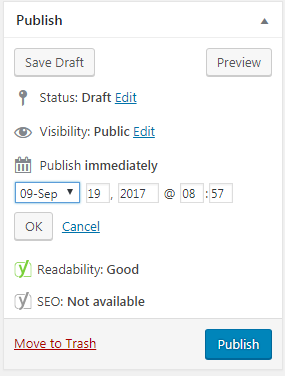Backfill your corporate history onto your blog for Google
| filed under: Uniform Resource Locator, Blog, MySQL, Content Marketing, Organic Search, Website, Open-source software, Internet Marketing, YouTube, Wayback Machine, HTML, Search Engine Optimization, SEO, Blogging, Web hosting service, Internet service provider, social media, Search and Content Marketing, Search Marketing, Internet Archive, Social Media/PR, WordPress, Content managementYou won’t confuse your visitors or piss off Google Search if you start posting historical newsletters, news items, press releases, product launches, and blog posts — as long as you’re honest.
Take advantage of the fact that most modern content management and blogging systems allow you to time-stamp your post with the current time; or, you can choose the year, month, day, hour, and minute yourself. And you should!
Everything But The Kitchen Sink
Go back and backfill everything that you can. You won’t get dinged by Google as long as you do your best to accurately timestamp your posts and uploads because if Google thinks you’re selling decade-old donuts as fresh and hot, then you’ll get in trouble. Google recognizes datestamps at an architectural level.
Google Webmaster Tools Data Highlighter
And, if you’re not certain, you should take a look at teaching Google about your site via Google Webmaster Tool’s Data Highlighter. I use it myself in order to instruct Google how to parse my Plone site since I don’t want to assume Google’s spiders and bots are as familiar with this open source Zope– and Python-based CMS:

I have actually been using the Internet Archive Wayback Machine to dig myself all the way back to 1996. It’s slow going but any time I find something that I have written, I post it onto my personal site and publish it on the date and time it was originally published. I will go deeper that just mining and harvesting the Wayback Machine, I will also scan and OCR any and all content that I can find from my own life and do my best to past and/or upload all that stuff into my site’s Zope Object Database (ZODB), tagging it with the proper year, month, day, and time — or as close as I can get.
Your Old Content Will Fill Google’s Missing Pieces
I am already getting traffic because I am filling in Google voids. Google abhors vacuums and the biggest vacuums in Google’s index and search engine has to do with history. For example, I was able to find a blog post I wrote on March 7, 2001, about my love affair with my Motorola T900 2-way pager.

There’s not a lot out there about them and so even though I “stole” my old content off of the Wayback Machine and then re-posted it onto my modern Chris Abraham blog, it doesn’t matter. I posted the post into my Plone CMS retroactively on Mar 07, 2001 12:00 AM, according to Plone, so I am obviously not remotely attempting to fool anyone–even Google knows that. But when I search for the Motorola T900 2-way pager on Google search today, my blog post from 2001 comes up 16th:

You really should be doing the same thing–just be painfully honest about the date of creation before you hit the publish button.
Google Always Chooses Deep Over Superficial
 The problem with most websites is that they’re not remotely deep enough. They’re just your driveway, your signage, your entrance way, your foyer, your window displays, and your showroom. They’re not your history, they’re rarely your museum, and they’re almost never any of the stuff from last season, from your attic, storage area, or deep within your warehouse.
The problem with most websites is that they’re not remotely deep enough. They’re just your driveway, your signage, your entrance way, your foyer, your window displays, and your showroom. They’re not your history, they’re rarely your museum, and they’re almost never any of the stuff from last season, from your attic, storage area, or deep within your warehouse.
Let’s say your company was incorporated in 1974, you got your first domain name and brochureware website in 1997, had a proprietary CMS-based website built for you at great expense in 2008, transitioned to WordPress in 2012, and finally implemented blogging and a newsroom in 2016.
Maybe you just started blogging and posting your press and news releases onto your commercial, professional, and personal website–an entire decade or two or three after you incorporated and ten or twenty years since you registered your first domain.
Push Your Interns Down The Rabbit Hole
You should probably give your interns the project because it’s a major time sink. I still recommend you do it, because even if your human visitors never click on your site map and fall down your historical rabbit hole, Google will. And, if Google does, then these ancient and possible irrelevant posts will bring people. A trickle, yes; but, depending on how many people you need to visit per every sales conversion, maybe that’s enough.
Don’t be afraid! Be sure to include all the content that you created before all the pivots and reinventions that you’ve make over the course of your company’s history.
Even though you’ve deleted those abandoned products and services, your archive of newsletters, press releases, and blog posts that predate those changes, will hook those people who are looking for that. Once they get to your site, they’ll have the opportunity to get to know the new you.

Via Biznology

